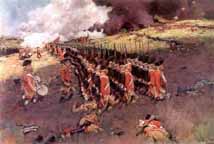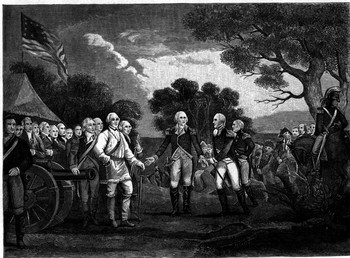William Howe was a British commander with two dozen years of military successes in North America. However, he is remembered as one of a handful of commanders-in-chief of British forces who didn't win the Revolutionary War. 
He was born on Aug. 10, 1729, the third and youngest son of Emanuel and Charlotte Howe. His mother had connections with the royal family, and this helped her sons later in life. Like many men of his generation, he went to school at Eton; also like many of his fellow Eton attendees, he joined the army, in his case when he was 17. His two brothers, George and Richard, would go on to military careers as well. Howe served for two years in Flanders, fighting in the War of the Austrian Succession. Among those he befriended during and after the war was his future North American commander, James Wolfe. The next conflict that Howe fought in was the Seven Years War, a European conflict that had a North American corollary called the French and Indian War. His older brother, George, died in a failed attack on Fort Ticonderoga, in 1758. In that same year, William Howe led a detachment of troops on an amphibious landing that successfully dislodged the French from the thought-to-be-impregnable fortress at Louisbourg and was cited for his bravery in action. 
He served under Wolfe during the siege of Quebec, leading an attack up a steep cliff from the St. Lawrence River to the Plains of Abraham, an action that paved the way for another British victory, on Sept. 13, 1759. Howe then served under Jeffery Amherst in the occupation of Montreal, in 1760. After a short action in Cuba in 1762, Howe returned home. He continued to rise through the army ranks and was promoted to major general in 1772. Two years later, he devised new training drills for infantry. He married Frances Connolly in 1765; they had no children. It was in 1774 that Parliament passed the Intolerable Acts, yet another set of taxes designed to convince the American colonists of their need to help pay off the French and Indian War debt. Howe, who had succeeded his brother George in Parliament in 1758, spoke out against the Intolerable Acts and told his constituents that he would not take up arms against the Americans if push came to shove. However, he answered his king's call to arms and agreed to sail to America as part of the British Army. He arrived on the same ship, the Cerberus, as two other major generals, John Burgoyne and Henry Clinton. They left England in March and arrived on May 25. When they landed, they discovered that war had begun, with shots fired at Lexington and Concord in April. 
Howe, Burgoyne, and Clinton arrived with 4,000 reinforcements, called for by then-commander-in-chief Thomas Gage, who found himself besieged in Boston. Determined to dislodge a colonial force that had fortified Breed's Hill, the British command decided on a frontal assault. Howe himself led the right wing of the attack in what has come to be called the Battle of Bunker Hill. It took three assaults before Howe achieved his goal. He declared the day a success but one that had come at too high a cost: British dead numbered more than 1,000. The British Government recalled Gage on Oct. 11, 1775, and Howe succeeded him as commander-in-chief. The plan then became one of isolation: Howe thought that he could cut off New England from the rest of the 13 Colonies and contain the rebellion there. To that end, Howe stayed in Boston for the winter, enjoying a bit of the high life. 
Spoiling Howe's reverie a bit was the Continental Army's March 1776 occupation of Dorchester Heights, overlooking Boston town and harbor, not only with troops but also with heavy artillery that Col. Henry Knox and others had liberated from Fort Ticonderoga. Howe was intending a frontal assault on that position as well, but a snowstorm canceled those plans and convinced him not to renew them. British troops left Boston on March 17. They left by ship, courtesy of a large fleet delivered by Howe's other brother, Admiral Richard Howe, and went to Halifax, Nova Scotia, and then to New York. All told, the number of British troops as about 24,000 and the number of newly hired Hessian mercenaries was about 8,000–far more than the Continental Army had. It took many weeks for all men, supplies, and equipment to be delivered. Howe next turned his focus to New York City. It was here that he had great success, eventually occupying Brooklyn and then Manhattan and, after victory at the Battle of White Plains, driving George Washington and the Colonial Army out of New York. The superior numbers in men and firepower were enough to overcome the defending colonials. 
In the middle of all of this fighting in and around New York came a peace conference. Howe himself met with three representatives from the Continental Congress–John Adams, Benjamin Franklin, and Edward Rutledge–on Sept. 7, 1776, two months after the signing of the Declaration of Independence. The two sides could not find common ground, and it was the last such attempt at mediation. The Battle of White Plains took place in October. Howe's men won the field, but Washington's men escaped into New Jersey. The British followed, chasing the Americans across the Delaware River. Seeing the force so few and so far from supply lines, Howe decided not to pursue and settled down for the winter. British forces were sprinkled up and down New Jersey. Washington and his forces achieved the element of surprise by crossing the Delaware River on Christmas, and they defeated a Hessian force at Trenton and then a larger force, under General Charles Cornwallis at Princeton. Howe withdrew to New York City. The major campaign of 1777 for Howe was the taking of Philadelphia, then the American capital. The British won significant victories, again under Cornwallis, at Brandywine on September 11 and at Germantown on October 4, and then the British properly settled in to Philadelphia, which they had recently occupied, forcing Washington and his men into winter quarters at Valley Forge. 
All of these victories were important to the British war effort, but Howe had also pledged to support actions in the north. He was supposed to participate in a three-pronged attack on Albany, meeting up with forces commanded by John Burgoyne and Barry St. Leger. For a variety of reasons, Howe did not take part in this endeavor. The result was an American victory at Saratoga, on October 17, which eventually brought France into the war on the side of the Americans. Not long after that, Howe submitted his resignation. It took several months for it all to be arranged, and Howe sailed for England in May 1778. Replacing him was commander-in-chief was Henry Clinton. Howe was roundly blamed for the defeat at Saratoga and for the inability to capture Washington and defeat the ragtag Continental Army. (His brother Richard had resigned as well, and they were both censured. A later parliamentary inquiry was inconclusive, satisfying neither the Howes nor their accusers.) Howe also lost his seat in Parliament. He never again held a position for active combat, although he was promoted to full general in 1793, in the midst of the French Revolutionary Wars, and commanded the defense of a series of outposts in Great Britain. King George III had appointed him lieutenant general of the ordnance in 1782; he held that post until 1803. He was also appointed governor of Berwick-on-Tweed in 1795 and governor of Plymouth in 1805. Richard Howe died in 1799, and William Howe succeeded him as the Viscount Howe and Baron Clenawly. His health declined for a number of years, and he died on July 12, 1814, in Plymouth. |
|
Social Studies for Kids
copyright 2002–2024
David White




